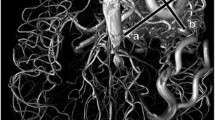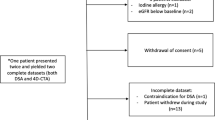Abstract
Background
MR digital subtraction angiography (MR-DSA) is a contrast-enhanced MR angiographic sequence that enables time-resolved evaluation of the cerebral circulation.
Objective
We describe the feasibility and technical success of our attempts at MR-DSA for the assessment of intracranial pathology in children.
Materials and methods
We performed MR-DSA in 15 children (age range 5 days to 16 years) referred for MR imaging because of known or suspected intracranial pathology that required a dynamic assessment of the cerebral vasculature. MR-DSA consisted of a thick (6–10 mm) slice-selective RF-spoiled fast gradient-echo sequence (RF-FAST) acquired before and during passage of an intravenously administered bolus of Gd-DTPA. The images were subtracted and viewed as a cine loop.
Results
MR-DSA was performed successfully in all patients. High-flow lesions were shown in four patients; these included vein of Galen aneurysmal malformation, dural fistula, and two partially treated arteriovenous malformations (AVMs). Low-flow lesions were seen in three patients, all of which were tumours. Normal flow was confirmed in eight patients including two with successfully treated AVMs, and in three patients with cavernomas.
Conclusion
Our early experience suggests that MR-DSA is a realistic, non-invasive alternative to catheter angiography in certain clinical settings.


Similar content being viewed by others
References
Hennig J, Scheffler K, Laubenberger J, et al (1997) Time-resolved projection angiography after bolus injection of contrast agent. Magn Reson Med 37:341–345
Aoki S, Yoshikawa T, Hori M, et al (2000) MR digital subtraction angiography for the assessment of intracranial arteriovenous malformations and fistulas. AJR 175:451–453
Strecker R, Scheffler K, Klisch J, et al (2000) Fast functional MRA using time-resolved projection MR angiography with correlation analysis. Magn Reson Med 43:303–309
Griffiths PD, Hoggard N, Warren DJ, et al (2000) Brain arteriovenous malformations: assessment with dynamic MR digital subtraction angiography. AJNR 21:1892–1899
Farb RI, McGregor C, Kim JK, et al (2001) Intracranial arteriovenous malformations: real-time auto-triggered elliptic centric-ordered 3D gadolinium-enhanced MR angiography – initial assessment. Radiology 220:244–251
Klisch J, Strecker R, Hennig J, et al (2000) Time-resolved projection MRA: clinical application in intracranial vascular malformations. Neuroradiology 42:104–107
Tsuchiya K, Katase S, Yoshino A, et al (2000) MR digital subtraction angiography of cerebral arteriovenous malformations. AJNR 21:707–711
Barger AV, Block WF, Toropov Y, et al (2002) Time-resolved contrast-enhanced imaging with isotropic resolution and broad coverage using an undersampled 3D projection trajectory. Magn Reson Med 48:297–305
Mori H, Aoki S, Okubo T, et al (2003) Two dimensional thick slice MR digital subtraction angiography in the assessment of small to medium size intracranial arteriovenous malformations. Neuroradiology 45:27–33
Chooi WK, Woodhouse N, Coley SC, et al (2004) Pediatric head and neck lesions: assessment of vascularity by MR digital subtraction angiography. AJNR 25:1251–1255
Ziyeh S, Schumaker M, Strecker R, et al (2003) Head and neck vascular malformations: time-resolved MR projection angiography. Neuroradiology 45:681–686
Wetzel SG, Bilecen D, Lyrer P, et al (2000) Cerebral dural arteriovenous fistulas: detection by dynamic MR projection angiography. AJR 174:1293–1295
Coley SC, Romanowski CA, Hodgson TJ, et al (2002) Dural arteriovenous fistulae: non-invasive diagnosis with dynamic MR digital subtraction angiography. AJNR 23:404–407
Evans AL, Coley SC, Wilkinson ID, et al (2005) First-line investigation of acute intracerebral haemorrhage using dynamic magnetic resonance angiography. Acta Radiol 46:625–630
Author information
Authors and Affiliations
Corresponding author
Rights and permissions
About this article
Cite this article
Chooi, W.K., Connolly, D.J.A., Coley, S.C. et al. Assessment of blood supply to intracranial pathologies in children using MR digital subtraction angiography. Pediatr Radiol 36, 1057–1062 (2006). https://doi.org/10.1007/s00247-006-0268-1
Received:
Revised:
Accepted:
Published:
Issue Date:
DOI: https://doi.org/10.1007/s00247-006-0268-1




